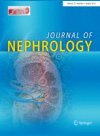Prognostic impact of neutrophil-to-lymphocyte ratio and vascular access in patients on chronic hemodialysis
Abstract
Background
The neutrophil-to-lymphocyte ratio, platelet-to-lymphocyte ratio, and derived-neutrophil-to-lymphocyte ratio (d-NLR), which can be obtained from complete blood count, have gained attention due to their widespread availability and low cost of testing; they have recently been proposed as prognostic markers in various chronic diseases. The primary objective of our study was to investigate the potential prognostic role of inflammatory markers derived from blood cell counts regarding all-cause mortality in patients with kidney failure undergoing hemodialysis, and the use of such markers in risk stratification based on the type of vascular access used.
Methods
This retrospective study included 236 patients from the Nephrology Unit of Trento. Demographic, anamnestic, clinical, and biochemical data, as well as total mortality, were collected. Neutrophil-to-lymphocyte ratio and the erythropoietin resistance index were calculated.
Results
The study cohort was divided into tertiles based on the neutrophil-to-lymphocyte ratio distribution. Patients in the third tertile exhibited significantly lower mean values of weight, serum albumin, serum iron, and transferrin, whereas mean erythropoietin resistance index values, and age were higher compared to those in the first and second tertiles, in which mortalilty was also higher. The area under the ROC curve (AUC) for neutrophil-to-lymphocyte ratio related to total mortality (AUC = 0.64) was wider than that for C-reactive protein (AUC = 0.61). Cox regression analysis suggested that neutrophil-to-lymphocyte ratio was independently associated with mortality, even after adjusting for confounding factors.
Conclusion
Our study suggests that neutrophil-to-lymphocyte ratio is a useful tool for the early risk stratification and management of patients with kidney failure.
Graphical abstract




